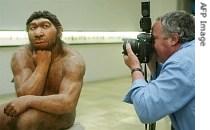2006年VOA标准英语-Neanderthal Gene Studies Define Ties to Modern(在线收听)
By David McAlary
Washington
15 November 2006
Examination of a bone fragment from our long extinct relatives, the Neanderthals, has yielded unprecedented genetic information about their mysterious relationship to modern humans. It shows that both human species diverged from a common ancestor about 500,000 years ago, give or take a few hundred thousand years, but that there has been little, if any, mingling since then.
 |
| Photographer takes pictures of a statue portraying a Neanderthal man at Prehistoric Museum in Halle, Germany |
"Instead of being a data-poor field largely based on bones and associated artifacts, it will become a data-rich field associated with DNA and enormous amounts, billions of bits, of data that will be freely available on the Internet," said gene expert Edward Rubin of the U.S. Government's Lawrence Berkeley National Laboratory in California.
He and colleagues extracted a tiny amount of DNA from the Neanderthal bone and examined the structure of about two percent of its genome. The results are in the journal Nature.
Another team, led by geneticist Svante Paabo of the Max Planck Institute for Evolutionary Anthropology in Leipzig, Germany, used a different technique to analyze about one-third of the Neanderthal genetic sequence from the same bone. These findings appear in the journal Science.
Mr. Rubin says among the findings is that Neanderthals were genetically the closest relatives to modern humans.
"By comparing the entire Neanderthal sequence that we had to the human sequence, we saw that both were very, very close to each other, from 99.5 percent to almost 99.9 percent identical," he added.
Another major discovery is that the lines that led to Neanderthals and modern humans split from a common ancestor roughly 500,000 years ago. The researchers say the date might be refined as larger genetic sequences are analyzed.
But did the two species ever interbreed? That has been a key question among anthropologists, who have differing opinions. The new genetic studies show no evidence for it, but Svante Paabo says it will take further DNA analysis to rule it out. He says more Neanderthal bone discoveries from different regions would help clarify the issue.
"If we start seeing evidence for some interaction from modern humans into Neanderthals, that may be regionalized,” he said. “That may be different in the Balkans than it is in central Europe, for example. We are continuing to look for bones, but we don't have anything in hand yet."
Paabo says a complete Neanderthal genome should be available in two years for more detailed comparison to the human genome and to that of the chimpanzee, the closest living relative to humans.
Edward Rubin says such matching will help researchers better understand the biology and behavior of Neanderthals, who became extinct about 30,000 years ago.
"All the functional data will come from the human genome, and the more we know about the human genome, the more we will know about Neanderthals," he added.